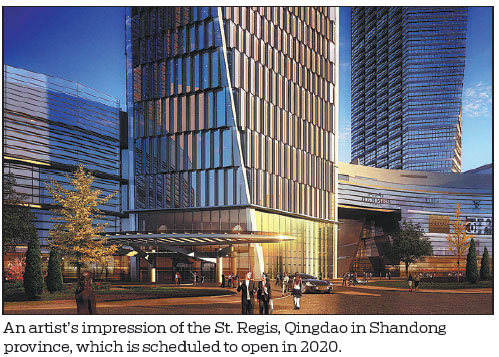Ritz-Carlton riding wave of tourism with new hotel
Luxury brand shares vision of how hospitality is evolving in China
The Ritz-Carlton, Xi'an in Northwest China's Shaanxi province opened in late June, the 13th Chinese property for the legendary brand.
Designed by Remedios Studio, which is also behind luxury hotels including Four Seasons, New York; The Grand Hyatt, Tokyo; and Landmark Mandarin Oriental, Hong Kong, the new hotel in Xi'an is imbued with a spirit of timeless luxury that reveals the distinctive soul of the city. Interiors pay homage to the architecture, history and culture of Xi'an through patterned motifs created by local artisans that offer a thoughtful path toward discovering the hidden parts of the destination.
The Ritz-Carlton, Xi'an is among the eight luxury properties to be unveiled by Marriott International, one of the world's biggest hospitality groups, in China this year.


Headquartered in the United States, Marriott International has a portfolio of eight luxury brands, including St. Regis and W. The company has nearly 100 luxury hotels in the pipeline in the Asia-Pacific region, adding to its current chain of more than 130 hotels. China represents more than half of the luxury pipeline.
Rainer Burkle, area vice-president of Marriott International Greater China's luxury sector, shared with China Daily his vision for the evolution of the tourism industry in China and how it has exercised an influence globally.
Why has The Ritz-Carlton chosen Xi'an for its latest hotel?
Haikou (in South China's Hainan province) saw the opening of our last Ritz-Carlton property more than two years ago. When you have something good, you have to wait a little longer.
Xi'an is the city that can accommodate an ultra luxury hotel, not only because of its history as an ancient capital and its location on the Silk Road, but also because of its connectivity and dynamism.
Less than one year ago, W Hotel also opened in Xi'an. Do you think there could be an oversupply of luxury rooms in the city?
There is a steady clientele of fans for every brand, but nowadays the majority of travelers are opening themselves to different experiences for different occasions. Like in Sanya, where 24 percent of local luxury hospitality business is managed by Marriott International, we see guests checking in at St. Regis for three days and Edition for another three days on one trip.
Our customers frequent different brands up and down, not only in the sector of luxury, but the expectations are different, so the touch and feel we provide have to be different.

Of course, ultimately it's also about service. At The Ritz-Carlton, everything is more careful while at W, it could be more bold and witty. W is very young and for those who are young at heart.
Is it something you see in China only, the trend of the same traveler trying different brands?
I think there are two answers to give. One is that we see it worldwide. But from what I have learned here, I believe Chinese are a little bit faster than everybody else. I think that will not only influence our hotels in China, but worldwide. Marriott International, as a global company, has many times looked at China and asked what is happening here.
There were 150 million overseas trips made by Chinese last year. That's for sure an amount to be noticed. The growth of the market has been so tremendous that it's fair to call it an evolution, and I believe this is going to continue.
What do you see as the most significant change in tourism in recent years?
The behavior that going somewhere, taking a picture and showing to others that I have been there still exists. But the more notable thing is the experience connected with the trip, and the rising expectations and knowledge about it.
Marriott International is one of the largest hotel companies in the world. While scale has given us tremendous advantages when we communicate with partners, we have also been trying to focus on individual properties and brands.
How would you define luxury in the hospitality industry today?
It's a combination of time and space.
Space is not only measured in square meters covered, but also how it is created. Time is for our staff, be it the "ladies and gentlemen" at The Ritz-Carlton or "butlers" at St. Regis, to take away all the hassles for guests. Time is the most precious gift in life. While we cannot extend the time available to each individual, we may expand what one can achieve in the period of time. I believe it's enrichment and luxury.
The guests who frequent luxury hotels are no longer the stereotypes we used to have decades ago. In the past, we were able to recognize a luxury businessman or traveler on the street. Now we couldn't. What's more, in the old days luxury was very much subscribed, mostly to meet a number of standards. Now the illustration of the word luxury has expanded. Just look at W and Edition. Even our classic hotels today have relaxed and cheered up a little bit.
But luxury continues to be a scarcity and exclusivity.
xujunqian@chinadaily.com.cn
(China Daily 07/27/2019 page6)














